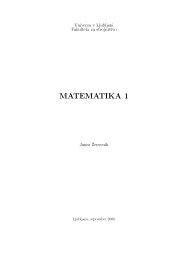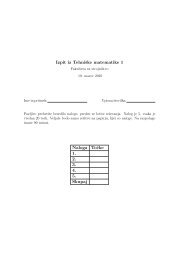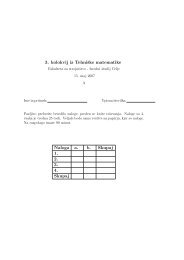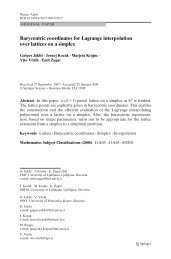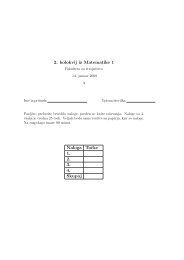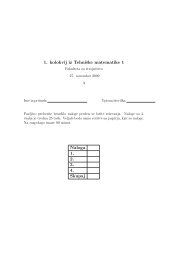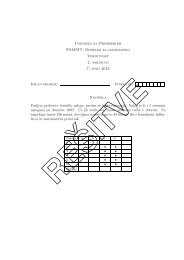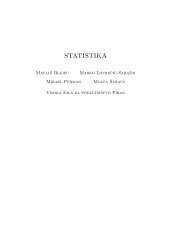Planar cubic G1 interpolatory splines with small strain energy
Planar cubic G1 interpolatory splines with small strain energy
Planar cubic G1 interpolatory splines with small strain energy
Create successful ePaper yourself
Turn your PDF publications into a flip-book with our unique Google optimized e-Paper software.
analysis is concerned, linear schemes can give better results when interpolationof separated data is needed. In the later case, some other criteria becomeimportant, such as the shape of the curve, its <strong>strain</strong> <strong>energy</strong>, curvature, convexity,.. . This leads to so called shape preserving techniques, nowadays a verywell understood topic (see [8], [17], [12], [1], [3], [2], e.g.).In general, there are two classes of interpolation problems, Lagrange and Hermite.While the first one requires only data points, the second one needs alsosome information on derivatives. Although Lagrange interpolation problemsseem easier to solve, Hermite ones are much more simple to handle. But theyhave a serious drawback, derivatives are rarely available in practice. This usuallyrequires a generation of artificial data.When dealing <strong>with</strong> <strong>splines</strong>, two kinds of smoothness conditions at the breakpointsare encountered, parametric and geometric continuity. While the firstone requires continuity of derivatives up to some order, the second one relaxesthese conditions to continuity of geometric quantities, such as tangentdirections, curvatures,. . . , only. When G 1 (or C 1 ) smoothness is required, thechoice of tangent directions at data points becomes vital, since it significantlyinfluences the shape of the spline. Usually there are three possibilities:• Tangent directions are given in advance.• The choice of appropriate directions is left to the designer.• An interpolating spline is required to be G 1 continuous, but the tangentdirections are not specified.While the first two approaches lead to local interpolating schemes, the last oneimplies a global set of conditions given as a large (fortunately banded) systemof linear equations. Note that the second approach should be applied just forlocal changes of the spline, otherwise quickly geometrically non-feasible curvescan be obtained, that are not pleasing to the human eye.Since tangent directions are rarely available in practice, they should be determinedby some simple procedure, preferably by an easy and geometricallyevident construction.In this paper a new method for the construction of a <strong>cubic</strong> G 1 continuous<strong>interpolatory</strong> spline curve is proposed, where the only data prescribed areinterpolation points, while tangent directions are unknown. They are constructedautomatically in such a way that a particular minimization of the<strong>strain</strong> <strong>energy</strong> of the spline curve is done. The resulting spline curve is constructedlocally and is regular, cusp-, loop- and fold-free. Furthermore, it issatisfactory as far as the shape of the curve is concerned.The paper is organized as follows. In the next section the problem considered isoutlined. In Section 3 the minimization approach is described. Necessary and2
where α i,k−i+1 > 0 are unknown scalars, d k are normalized tangent directionvectors, and P 3 is the space of planar parametric polynomials of degree ≤ 3.Of course, there are infinitely many solutions for the above problem, since itis well known that any set of α i,k−i+1 > 0 and d k gives a unique spline curves. Thus we have a large set of free parameters which can be used as shapeparameters of the spline.One of the approaches for choosing the parameters α := (α i,k−i+1 ) n,ii=1,k=i−1 ∈R 2n is to define a suitable functional and minimize it. Usually, the shape ofthe curve depends mostly on its curvature κ and therefore it seems reasonableto minimize the functionalϕ s (α) :=∫ tnt 0‖κ(t)‖ 2 dt =∫ tnt 0‖ṡ(t) × ¨s(t)‖ 2‖ṡ(t)‖ 6 dt. (2)The expression (2) is called the <strong>strain</strong> <strong>energy</strong> of the curve. In practice ([4],[19]), the approximate <strong>strain</strong> <strong>energy</strong> (called also linearized bending <strong>energy</strong>)ϕ(α) :=∫ tnt 0‖¨s(t)‖ 2 dt, (3)is used instead of (2). Note that the approximate <strong>strain</strong> <strong>energy</strong> is close to areal one if ‖ṡ(t)‖ ≈ 1. If this is not the case, it can be far away from thereal <strong>strain</strong> <strong>energy</strong>. But the beauty of the approximant lies in the fact that theminimization problem for the coefficients becomes linear. Note that ¨s mightnot be continuous, but it has only a finite number of finite jumps, thus theintegral (3) clearly exists. It is obvious that the minimization can be donelocally. Namely,min αϕ(α) =n∑i=1minα iϕ i (α i ),where∫ tiϕ i (α i ) := ‖¨s i (t)‖ 2 dt, (4)t i−1and α i := (α i,0 ,α i,1 ). It is clear from the geometry that the components ofα i should be positive, since otherwise the tangent vectors of s i at t i−1 and t iwould not have the same directions as given tangent directions d i−1 and d i .So one should have in mind that actually a con<strong>strain</strong>ed minimization of (4)has to be done, i.e.,min ϕ i (α i ), D i := {α i ∈ R 2 |α i > 0}.α i ∈D iNote that the inequality α i > 0 is considered componentwise. Unfortunately,as already observed in [20], for given tangent directions d i−1 , d i , the globalminimum is not always in D i , since the following theorem holds true.Theorem 1 ([20]) Let s i be the local Hermite interpolant on [t i−1 ,t i ] satisfying(1) and let β k = ∠(∆T i−1 ,d k ), k = i − 1,i (see Fig. 1) and β i−1,i :=4
∠(d i−1 ,d i ). Then the global minimum α i of ϕ i is given byα i,0 = 6 ∆T i−1 · d i−1 − 3 (∆T i−1 · d i ) (d i−1 · d i )∆t i−1(4 − (di−1 · d i ) 2) ,α i,1 = 6 ∆T i−1 · d i − 3 (∆T i−1 · d i−1 ) (d i−1 · d i )∆t i−1(4 − (di−1 · d i ) 2) .Furthermore, α i > 0 if and only if2 cos β i−1 − cos β i cos β i−1,i > 0 and 2 cos β i − cos β i−1 cos β i−1,i > 0.The resulting Hermite interpolant s i is regular on [t i−1 ,t i ] if additionallycos β i−1 > 1 3and cos β i > 1 3 . (5)Fig. 1. Single segment and critical betas.Fig. 2. Two segments.It is clear from Theorem 1 that tangent directions d i−1 and d i should satisfysome geometric con<strong>strain</strong>ts to assure that the minimum of ϕ i is in the desirabledomain D i and the resulting Hermite interpolant is regular. For the regularity,e.g., admissible positions of tangent directions are shown in Fig. 1. Thisbecomes very important when local Hermite interpolants are put together toform a spline curve. Consider namely two segments (see Fig. 2). If the angle∠(∆T i−1 , ∆T i ) > β i−1 + β i , then no tangent direction d i will guarantee theregularity of either s i or s i+1 . Since from (5) critical values for β i−1 and β iare ≈ 70.53 ◦ , the angle ∠(∆T i−1 , ∆T i ) should be less than 141.06 ◦ . In [20]this problem was solved by a preprocessing of data. The authors suggestedinserting additional two or three segments to achieve a desirable bound onthe above angle. Although the methods proposed in [20] are relatively simple,5
exact on the polynomial space of order ≤ k, where k is as large as possible. Themethod of undetermined coefficients or the Newton’s form of the interpolationpolynomial lead to¨s i (t i−1 ) ≈ 2 [t i−1 ,t i−1 ,t i ]s i , ¨s i (t i ) ≈ 2 [t i−1 ,t i ,t i ]s i ,and by (6), ϕ i can be approximated bywhereϕ i (α) ≈ 2∆t i−1ψ i (α), (7)∥ 1∥∥∥∥ 2ψ i (α) :=∆T∥ i−1 − α i,0 d i−1 +∆t i−1∥ α i,1 d i − 1∥ ∥∥∥∥ 2∆T i−1 . (8)∆t i−1Theorem 2 The nonlinear functional ψ i , i = 1, 2,...,n, has a unique globalminimum in the interior of D i iffα ∗ i := 1∆t i−1(d i−1 · ∆T i−1 ,d i · ∆T i−1 ) T > 0.Furthermore,wheremin ψ i (α i ) = 2 − c2 i,0 − c 2 i,1‖∆Tα i ∈D i (∆t i−1 ) 2 i−1 ‖ 2 ,c i,k = cos ∠ (d i+k−1 , ∆T i−1 ) , k = 0, 1.PROOF. The functional (8) can be simplified toψ i (α i ) =1 ((∆ti−1 ) ( )2 α 2(∆t i−1 ) 2 i,0 + αi,12− 2 ∆t i−1 (α i,0 d i−1 + α i,1 d i ) · ∆T i−1 + 2 ‖∆T i−1 ‖ 2) .Note that ψ i is convex. Its gradient vanishes at α ∗ i := ( α ∗ i,0,α ∗ i,1) T, wherewhich leads to a unique minimumα ∗ i,k = d i+k−1 · ∆T i−1∆t i−1, k = 0, 1,ψ i (α ∗ i) = 2 − c2 i,0 − c 2 i,1(∆t i−1 ) 2 ‖∆T i−1 ‖ 2 .The point α ∗ i is in D i iff its components are positive. This concludes the proofof the theorem.7
Notice that the minimal value of the functional ψ i can also be zero. In thiscase c i,0 = c i,1 = 1 (or −1, but in this case the curve has an undesired fold),and the <strong>cubic</strong> parametric spline segment s i reduces to a straight line s i (t) =T i−1 + (t − t i−1 )[t i−1 ,t i ]s i .Corollary 3 The conditions α ∗ i > 0, i = 1, 2,...,n, have a simple geometricinterpretation, i.e., ∠ (d i+k−1 , ∆T i−1 ) ∈ [0, π ), k = 0, 1.2Now suppose that the assumptions of Theorem 2 are satisfied. Then an importantquestion arises whether the resulting <strong>cubic</strong> spline segment s i is regularon [t i−1 ,t i ], i = 1, 2,...,n. The answer is affirmative, even more, s i has nocusps, loops or folds.Theorem 4 Let the assumptions of Theorem 2 be satisfied and let s i , i =1, 2,...,n, be the resulting Hermite geometric interpolant defined by (1). Thenthe spline segment s i is regular, loop-, cusp-, and fold-free.PROOF. Let us reparameterize s i by a local parameter u = (t−t i−1 )/∆t i−1 ,i.e., let p i (u) := s i (t), t ∈ [t i−1 ,t i ]. It is enough to show that p i is regular,loop-, cusp-, and fold-free on [0, 1]. By (1) and Theorem 2p i (k) = T i+k−1 , k = 0, 1,p ′ i(k) = ∆t i−1 α i,k d i+k−1 = (d i+k−1 · ∆T i−1 )d i+k−1 , k = 0, 1.Clearly, p i can be written in the Bézier form asp i (u) = T i−1 B0(u) 3 +(T i−1 + 1 )3 (d i−1 · ∆T i−1 )d i−1 B1(u)3+(T i − 1 )3 (d i · ∆T i−1 )d i B2(u) 3 + T i B3(u),3where B 3 i , i = 0, 1, 2, 3, are <strong>cubic</strong> Bernstein polynomials. By using a translationand a rotation we can further assume that T i−1 = (0, 0) T and T i = (x 1 , 0) T ,x 1 > 0. Since by Theorem 2, α ∗ i > 0, the conclusion that d i+k−1,1 > 0,k = 0, 1, where d i+k−1,1 is the first component of d i+k−1 , follows immediately.A differentiation of p i yieldsp ′ i(u) = (d i−1 · ∆T i−1 )d i−1 B 2 0(u) + (3 ∆T i−1 − (d i−1 · ∆T i−1 )d i−1−(d i · ∆T i−1 )d i ) B 2 1(u) + (d i · ∆T i−1 )d i B 2 2(u).Let p ′ i,1 be the first component of p ′ i. To see that p i is regular and loop-, cuspandfold-free on [0, 1], it is enough to verify that p ′ i,1(u) > 0 for u ∈ [0, 1] (see[6], e.g.). Quite clearlyp ′ i,1(u) = x 1(d2i−1,1 B 2 0(u) + ( 3 − d 2 i−1,1 − d 2 i,1)B21 (u) + d 2 i,1 B 2 2(u) ) .8
Since d i are normalized and d i+k−1,1 > 0, the conclusion 0 < d i+k−1,1 < 1,k = 0, 1, follows. Since also x 1 > 0, all the Bézier coefficients of p ′ i,1 arepositive and by the convex hull property of Bézier curves, p ′ i,1 is positive on[0, 1]. This concludes the proof of the theorem.4 Construction of tangent directionsIn the previous section, a construction of the <strong>cubic</strong> Hermite G 1 polynomialspline curve, based on a minimization of <strong>energy</strong>, has been derived. We haveassumed that the unit tangent directions d i are known in advance and theparameters α ∗ i are obtained by a particular minimization technique. As it isclear from Theorem 2, tangent directions must be chosen carefully.In this section the problem of the construction of tangent directions d i will beaddressed. From Theorem 2 it is enough to required i+k−1 · ∆T i−1 > 0, i = 1, 2,...,n, k = 0, 1.In order to fulfill these conditions, consider the i-th and (i + 1)-th segment ofthe spline curve s (see Fig. 3). Let us define a rotationand z i := sign (∆T i−1 × ∆T i ). Further, let⎛ ⎞⎜R :=0 −1 ⎟⎝ ⎠ (9)1 0u i := z i R ∆T i−1 , v i := −z i R ∆T i , w i := λ i u i + (1 − λ i )v i , λ i ∈ R.(10)It is now easy to prove the following lemma.Lemma 5 If z i ≠ 0 and λ i ∈ (0, 1), then w i · ∆T j > 0, j = i − 1,i.PROOF. We will prove that w i · ∆T j > 0, j = i − 1. The proof for j = iis very similar and will be omitted. Take any w i = λ i u i + (1 − λ i )v i <strong>with</strong>λ i ∈ (0, 1). By (9) and (10)w i · ∆T i−1 = λ i u i · ∆T i−1 + (1 − λ i )v i · ∆T i−1= −(1 − λ i )z i (R ∆T i ) · ∆T i−1 ,since u i and ∆T i−1 are perpendicular to each other. Obviously, it is enoughto show thatz i = −sign ((R ∆T i ) · ∆T i−1 ).9
Since z i ≠ 0, ∠ (∆T i−1 , ∆T i ) ≠ 0,π, and there are two possibilities.(a) If z i > 0, then ∠ (R∆T i , ∆T i−1 ) > π/2 and sign ((R∆T i ) · ∆T i−1 ) < 0.(b) If z i < 0, then ∠ (R∆T i , ∆T i−1 ) < π/2 and sign ((R∆T i ) · ∆T i−1 ) > 0.This concludes the proof of the lemma.From Lemma 5 it follows that any λ i ∈ (0, 1) gives w i that leads to the minimizationof the functional (8). Namely, one just takes d i = w i /‖w i ‖. Thus λ i ,i = 1, 2,...,n, can be considered as free shape parameters. One of the choiceswould, e.g., be λ i = ‖∆T i ‖/(‖∆T i−1 ‖+‖∆T i ‖), which implies that d i pointsfrom T i in the direction of the bisector of the angle ∠(∆T i−1 , ∆T i ) (see Fig. 3and Corollary 7). This is a natural heuristic choice since this d i stays awayFig. 3. Admissible positions of d i .from the unwanted directions implying α i,k = 0, for k = 0 or k = 1, as much aspossible. Lemma 5 excludes two possibilities, namely ∠ (∆T i−1 , ∆T i ) = 0,π.But, if the considered angle is equal to 0, then w i can be taken as w i = ∆T i ,and again the conclusions of the lemma follow. On the other hand, the casewhen the angle equals π would imply that any parameterization of such datahas a fold. Thus, this case should be excluded from possible data sets by usingsome kind of preprocessing of data points (by inserting an additional point,e.g.).For the first and the last tangent direction the above procedure can not be applied,but in this case d 0 and d n can be, e.g., chosen as d 0 = ∆T 0 /‖∆T 0 ‖ andd n = ∆T n−1 /‖∆T n−1 ‖. Thus for given shape parameters λ i ∈ (0, 1), the tangentdirections and the resulting Hermite G 1 <strong>cubic</strong> spline can be constructed.Theorem 2 allows a broad range of admissible tangent directions. Then thespline is constructed locally. A natural question arises, which is the optimaladmissible tangent direction. The answer is given by the following theorem.Theorem 6 The optimal tangent directions d i , such that the approximate10
<strong>strain</strong> <strong>energy</strong> (7) is minimized, are obtained by d i := w i /‖w i ‖, (10), and<strong>with</strong>λ i = 2 (∆t i) 3 u i · v iA 1 ± √ A 2, (11)A 1 := (∆t i−1 ) 3 ‖∆T i ‖ 2 + 2 (∆t i ) 3 u i · v i − (∆t i ) 3 ‖∆T i−1 ‖ 2 ,A 2 := ( (∆t i ) 3 ‖∆T i−1 ‖ 2 − (∆t i−1 ) 3 ‖∆T i ‖ 2) 2If u i · v i = 0, then+ 4 (∆t i−1 ) 3 (∆t i ) 3 (u i · v i ) 2 .a) λ i = 0 if z i = −1, orb) λ i = 1 if z i = 1.PROOF. Our goal is to find optimal tangent directions d i , such that the approximate<strong>strain</strong> <strong>energy</strong> (7) is minimized. Recall that if the tangent directionsare already known, by Theorem 2 optimal α i are obtained. Since the directiond i appears just in two neighbouring segments in (8), it is enough to minimizethe expression2∆t i−1∥ ∥∥∥∥α i,1 d i − 1∆t i−1∆T i−1∥ ∥∥∥∥ 2+ 2∆t i∥ ∥∥∥ 1∆t i∆T i − α i+1,0 d i∥ ∥∥∥ 2.By using Theorem 2 and (10), computing partial derivatives on λ i , and asomewhat tedious computation, the following quadratic equation is obtained(ρ(λ i ) := λ 2 i ((∆ti−1 ) 3 − (∆t i ) 3 )u i · v i + (∆t i ) 3 ‖∆T i−1 ‖ 2 − (∆t i−1 ) 3 ‖∆T i ‖ 2)(+ λ i (∆ti−1 ) 3 ‖∆T i ‖ 2 + 2 (∆t i ) 3 u i · v i − (∆t i ) 3 ‖∆T i−1 ‖ 2)− (∆t i ) 3 u i · v i = 0.Note that ρ(0)ρ(1) < 0, which implies that there is always a unique solutionin (0, 1). This determines the choice of the sign in (11). The case u i · v i = 0has to be analyzed separately. This concludes the proof.For a particular parameterization, the expression (11) considerably simplifies.In this case a part of A 2 vanishes together <strong>with</strong> the square root. The followingresult is obtained.Corollary 7 For the 2/3-parameterization (see [7]),∆t i−1∆t i=( )2‖∆T3 i−1 ‖ ,‖∆T i ‖11
the optimal tangent directions d i lie on bisectors of angles ∠(u i ,v i ),λ i :=‖∆T i ‖‖∆T i−1 ‖ + ‖∆T i ‖ .5 Numerical examplesLet us conclude the paper by some numerical examples. The <strong>cubic</strong> G 1 Hermiteinterpolant can closely resemble the C 2 <strong>cubic</strong> interpolating spline (Fig. 4),but for non-uniformly distributed data points (exchange of short and longsegments) larger differences between the curve shapes can occur.The influence of the shape parameters λ i on the curve can be clearly seen in(Fig. 4, right). For a comparison, approximate <strong>strain</strong> energies (3) for all thecurves are computed. Clearly the <strong>energy</strong> of the C 2 spline is the <strong>small</strong>est, butin some cases a simple ad-hoc procedure of selecting the bisector direction asan admissible tangent direction, gives a curve <strong>with</strong> suitably <strong>small</strong> approximate<strong>strain</strong> <strong>energy</strong>.Fig. 4. The <strong>cubic</strong> G 1 Hermite interpolant (black) closely resembles the C 2 <strong>cubic</strong>interpolating spline (gray) (left figure). Approximate <strong>strain</strong> energies are 218.8 and144.3, respectively. The optimal <strong>cubic</strong> G 1 Hermite interpolant (black) together <strong>with</strong>the one, obtained by an ad-hoc bisector choice of admissible tangent directionsare shown in the right figure. Approximate <strong>strain</strong> energies are 599.2 and 740.1,respectively.In Fig. 5, a comparison of curves, obtained by our method and [20], is presented.The data points are sampled from a unit circle. Since the algorithm in[20] requires tangent directions, two versions are considered. In the left figure,the gray curve is obtained by using tangents sampled from the circle, and inthe right figure it is obtained by using tangent directions, computed by ourmethod.12
Fig. 5. Comparison of the <strong>cubic</strong> G 1 Hermite interpolant (black) <strong>with</strong> [20] using thedata points and tangent directions sampled from a unit circle (left), and using thetangent directions, computed by our algorithm (right).In general, the method from [20] needs preprocessing and inserting new, artificialpoints. There are 11 particular cases, but not all of them are explicitlyderived. This makes an objective comparison of methods hard to do. Thus inFig. 5 the data were chosen in such a way that no additional points were required.The results show that the shapes of both curves are comparable. Thetime complexities of both methods are similar. Our method requires someadditional operations for tangent direction computation, however, [20] needstangent directions as data, and additional operations are needed for choosinga particular of 11 subroutines and new data construction.References[1] C. Conti and R. Morandi. Piecewise C 1 -shape-preserving Hermite interpolation.Computing, 56(4):323–341, 1996.[2] P. Costantini and M. L. Sampoli. A general scheme for shape preserving planarinterpolating curves. BIT, 43(2):297–317, 2003.[3] I. Cravero and C. Manni. Shape-preserving interpolants <strong>with</strong> high smoothness.J. Comput. Appl. Math., 157(2):383–405, 2003.[4] C. de Boor. A practical guide to <strong>splines</strong>, volume 27 of Applied MathematicalSciences. Springer-Verlag, New York, revised edition, 2001.[5] C. de Boor, K. Höllig, and M. Sabin. High accuracy geometric Hermiteinterpolation. Comput. Aided Geom. Design, 4(4):269–278, 1987.13
[6] G. Farin. Curves and surfaces for computer-aided geometric design. ComputerScience and Scientific Computing. Academic Press Inc., San Diego, CA, fourthedition, 1997.[7] M. S. Floater. On the deviation of a parametric <strong>cubic</strong> spline interpolant fromits data polygon. Comput. Aided Geom. Design, 25(3):148–156, 2008.[8] T. N. T. Goodman and K. Unsworth. Shape-preserving interpolation byparametrically defined curves. SIAM J. Numer. Anal., 25(6):1453–1465, 1988.[9] K. Höllig and J. Koch. Geometric Hermite interpolation <strong>with</strong> maximal orderand smoothness. Comput. Aided Geom. Design, 13(8):681–695, 1996.[10] G. Jaklič, J. Kozak, M. Krajnc, and E. Žagar. On geometric interpolation ofcircle-like curves. Comput. Aided Geom. Design, 24(5):241–251, 2007.[11] G. Jaklič, J. Kozak, M. Krajnc, and E. Žagar. On geometric interpolation byplanar parametric polynomial curves. Math. Comp., 76(260):1981–1993, 2007.[12] P. D. Kaklis and N. S. Sapidis. Convexity-preserving <strong>interpolatory</strong> parametric<strong>splines</strong> of non-uniform polynomial degree. Comput. Aided Geom. Design,12(1):1–26, 1995.[13] J. Kozak and M. Krajnc. Geometric interpolation by planar <strong>cubic</strong> G 1 <strong>splines</strong>.BIT, 47(3):547–563, 2007.[14] J. Kozak and E. Žagar. On geometric interpolation by polynomial curves. SIAMJ. Numer. Anal., 42(3):953–967, 2004.[15] E. T. Y. Lee. Choosing nodes in parametric curve interpolation. Comput. AidedDesign, 21(6):363–370, 1989.[16] K. Mørken and K. Scherer. A general framework for high-accuracy parametricinterpolation. Math. Comp., 66(217):237–260, 1997.[17] S. Pruess. Shape preserving C 2 <strong>cubic</strong> spline interpolation. IMA J. Numer.Anal., 13(4):493–507, 1993.[18] A. Rababah. High order approximation method for curves. Comput. AidedGeom. Design, 12(1):89–102, 1995.[19] J. Wallner. Note on curve and surface energies. Comput. Aided Geom. Design,24(8-9):494–498, 2007.[20] J.-H. Yong and F. Cheng. Geometric Hermite curves <strong>with</strong> minimum <strong>strain</strong><strong>energy</strong>. Comput. Aided Geom. Design, 21(3):281–301, 2004.14



